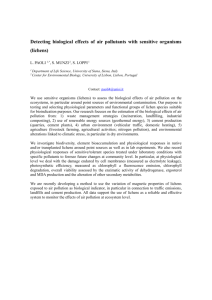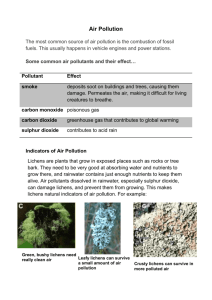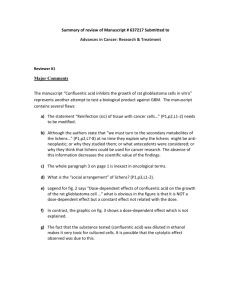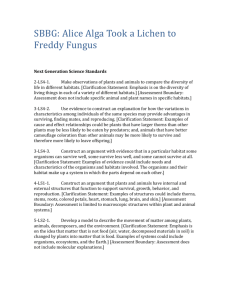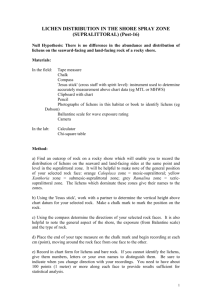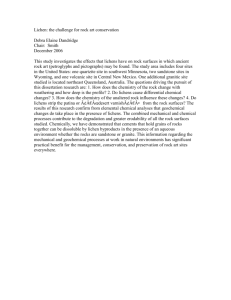Lichens - Tennessee State University
advertisement
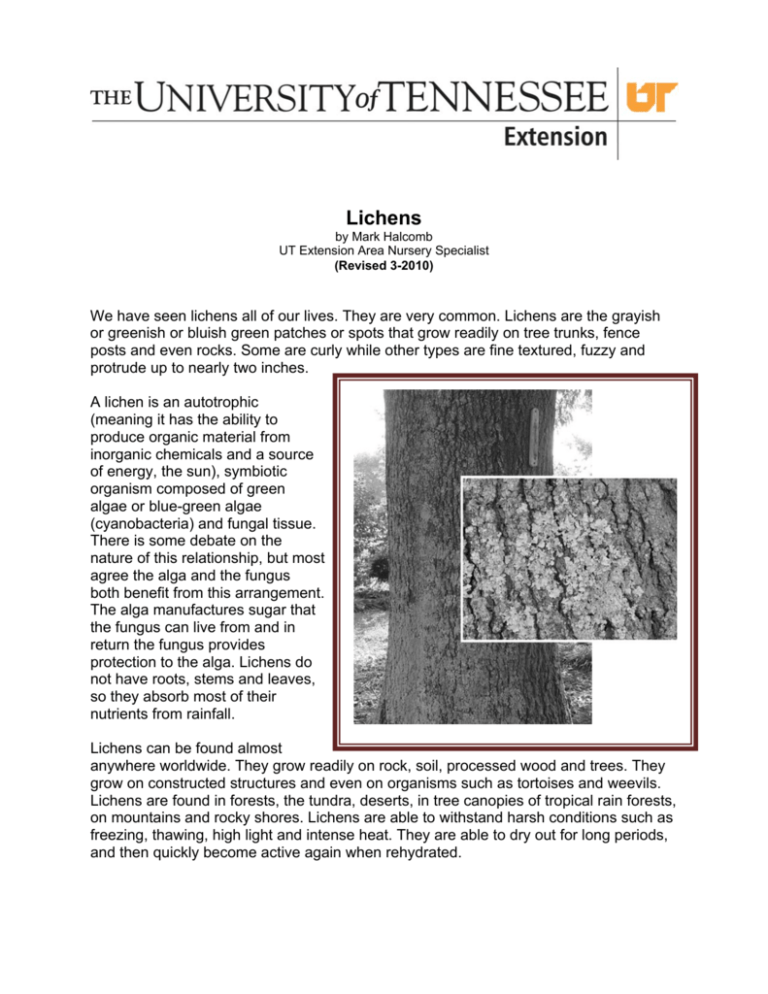
Lichens by Mark Halcomb UT Extension Area Nursery Specialist (Revised 3-2010) We have seen lichens all of our lives. They are very common. Lichens are the grayish or greenish or bluish green patches or spots that grow readily on tree trunks, fence posts and even rocks. Some are curly while other types are fine textured, fuzzy and protrude up to nearly two inches. A lichen is an autotrophic (meaning it has the ability to produce organic material from inorganic chemicals and a source of energy, the sun), symbiotic organism composed of green algae or blue-green algae (cyanobacteria) and fungal tissue. There is some debate on the nature of this relationship, but most agree the alga and the fungus both benefit from this arrangement. The alga manufactures sugar that the fungus can live from and in return the fungus provides protection to the alga. Lichens do not have roots, stems and leaves, so they absorb most of their nutrients from rainfall. Lichens can be found almost anywhere worldwide. They grow readily on rock, soil, processed wood and trees. They grow on constructed structures and even on organisms such as tortoises and weevils. Lichens are found in forests, the tundra, deserts, in tree canopies of tropical rain forests, on mountains and rocky shores. Lichens are able to withstand harsh conditions such as freezing, thawing, high light and intense heat. They are able to dry out for long periods, and then quickly become active again when rehydrated. Some other characteristics of lichens are that they are slow to evolve and slow to grow. Most forms grow only a few millimeters a year. Lichens are classified into three major types of communities, as well as three morphological groups. The three major communities are corticolous, which grow on tree bark; terricolous, which grow on soil; and saxicolous, which grow on rocks. The three morphological groups are fruticose (shrubby) lichens, foliose (leafy) lichens and crustose (crusty) lichens. Lichens play very significant roles in our biological world. Lichens act as air pollution indicators. Some fruticose types are used as indicators of unpolluted areas, while others are able to withstand high levels of pollution. Since lichens lack roots, nutrients that are dissolved in water are obtained through surface absorption of rainfall. Lichens act much like sponges, absorbing everything that is dissolved in the rainwater and retaining it. Since there is no means of purging antagonistic substances, these substances accumulate in the lichen and reach a level where they break down the chlorophyll molecules that are responsible for photosynthesis of the algae. Photosynthesis is the process green plants use to convert sunlight energy to chemical energy, which is used in the maintenance and growth of the plant. All lichens contain green chlorophyll, although other substances or pigments on the surface may make them appear gray, yellow or orange. Research has shown that lichens are not parasitic on higher plants. However, their growth may increase when branches lose leaves and die, due to increased light levels. Lichens are not the cause of branch dieback and tree death. Calls from nursery producers indicate that some buyers are really concerned about the presence of lichens on the trunks of our shade trees that we have shipped. Most of those expressing concern live in the north. They are not familiar with lichens. They assume the lichens are harmful. I suspect that lichens don’t grow where they live or they have not noticed them. Lichens do not live where the air is polluted. Hopefully this article will bring some awareness. Lichens are harmless, but some of our buyers may require some convincing. It is surprising that anyone would complain about something natural and so completely harmless. Perhaps the complainer hopes we will lower the price. I have attempted to document the harmless aspect of lichens in a way that might assist our industry. I realize that a northern buyer might not accept what someone in Tennessee would say. Suggest they contact their Cooperative Extension Service or visit the following web sites. A little honest education may solve the concern. Sources - Dr. Alan Windham, UT Extension plant pathologist - Brodo, I.M., S.D. Sharnoff and S. Sharnoff. 2001. Lichens of North America. Yale University Press, New Haven, CT. 795 p. -Hutchinson, J., D Maynard and L. Geiser. 1996. Air quality and lichens – a literature review emphasizing the Pacific Northwest, USA. Portland, OR: U.S. Department of Agriculture, Forest Service, Pacific Northwest Region 6, Pacific Northwest Region Air Resource Management Program www.fs.fed.us/r6/aq/lichen/almanac.html ________________________ For more information concerning lichens, please visit: http://www.backyardnature.net/lichens.htm http://www.chesco.com/~treeman/SHIGO/LICHENS.html http://extension.tennessee.edu/publications/spfiles/SP660.pdf http://www.extension.umn.edu/yardandgarden/ygbriefs/p429lichens.html http://www.utextension.utk.edu/publications/spfiles/SP660.pdf http://botany.si.edu/lichens http://www.botany.wisc.edu/wislichens http://nhc.asu.edu/lichens/lichen_info/lichen_info.jsp http://gis.nacse.org/lichenair/ Image by Wayne Clatterbuck, UT Forestry Comm/Disease/Lichens

